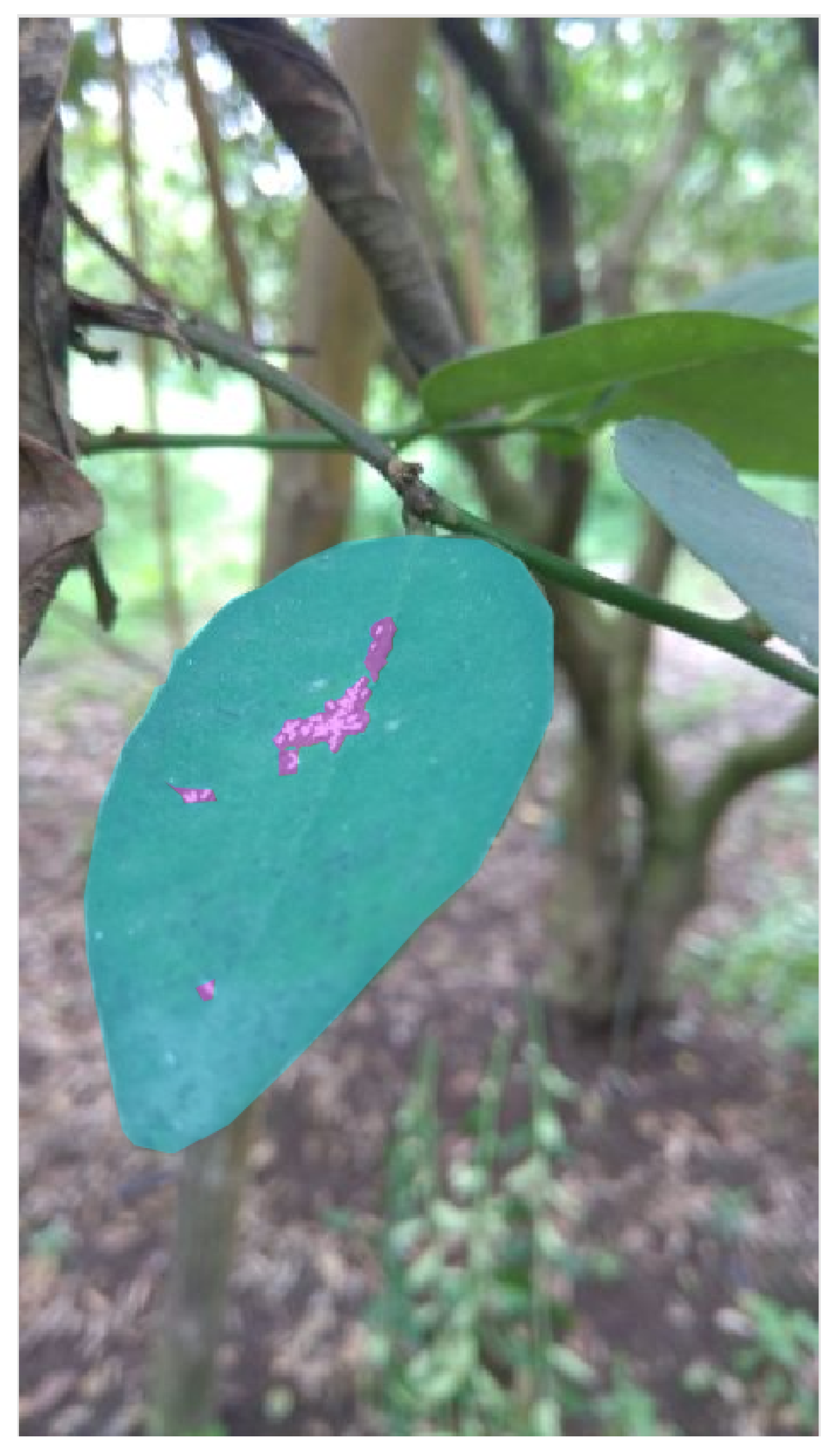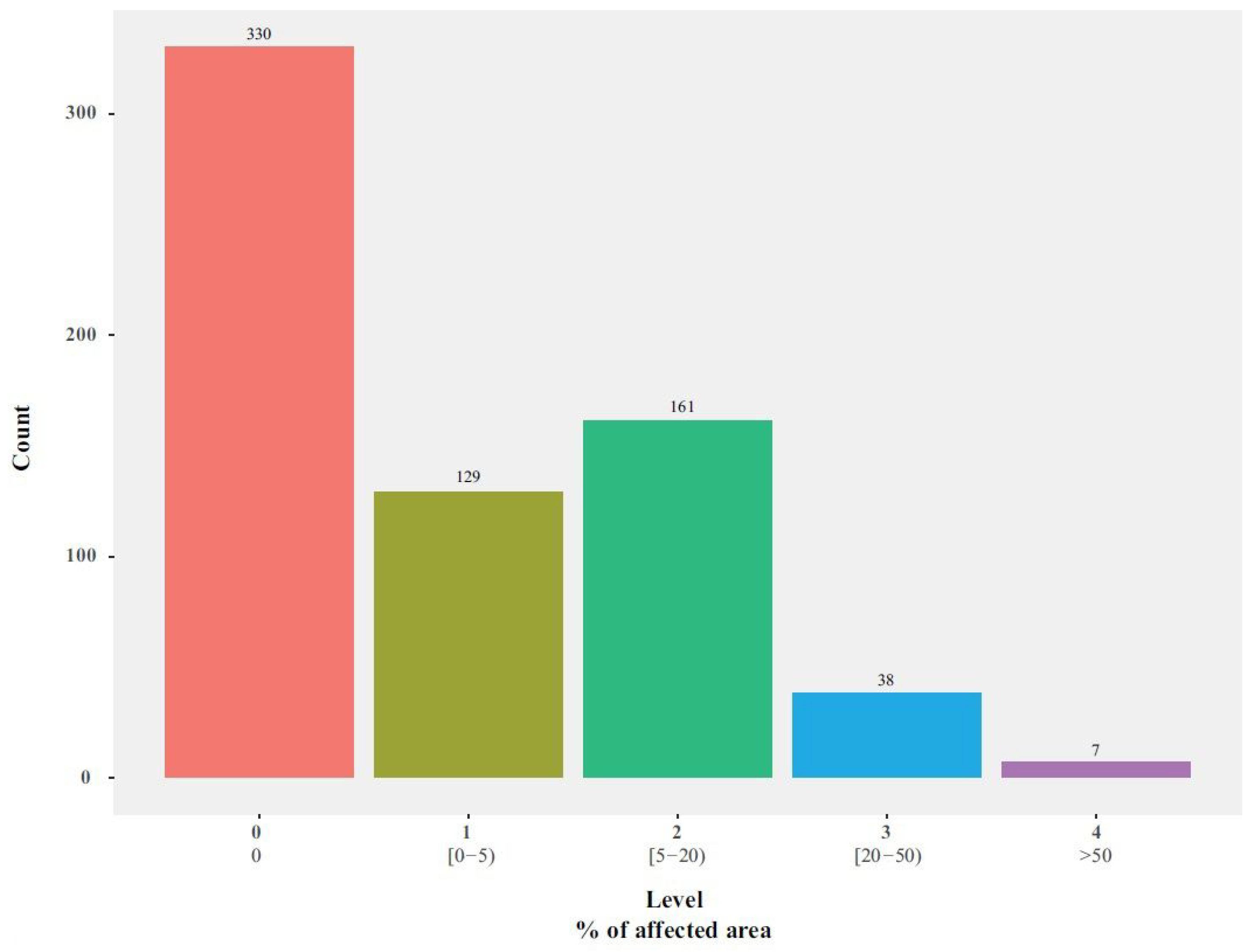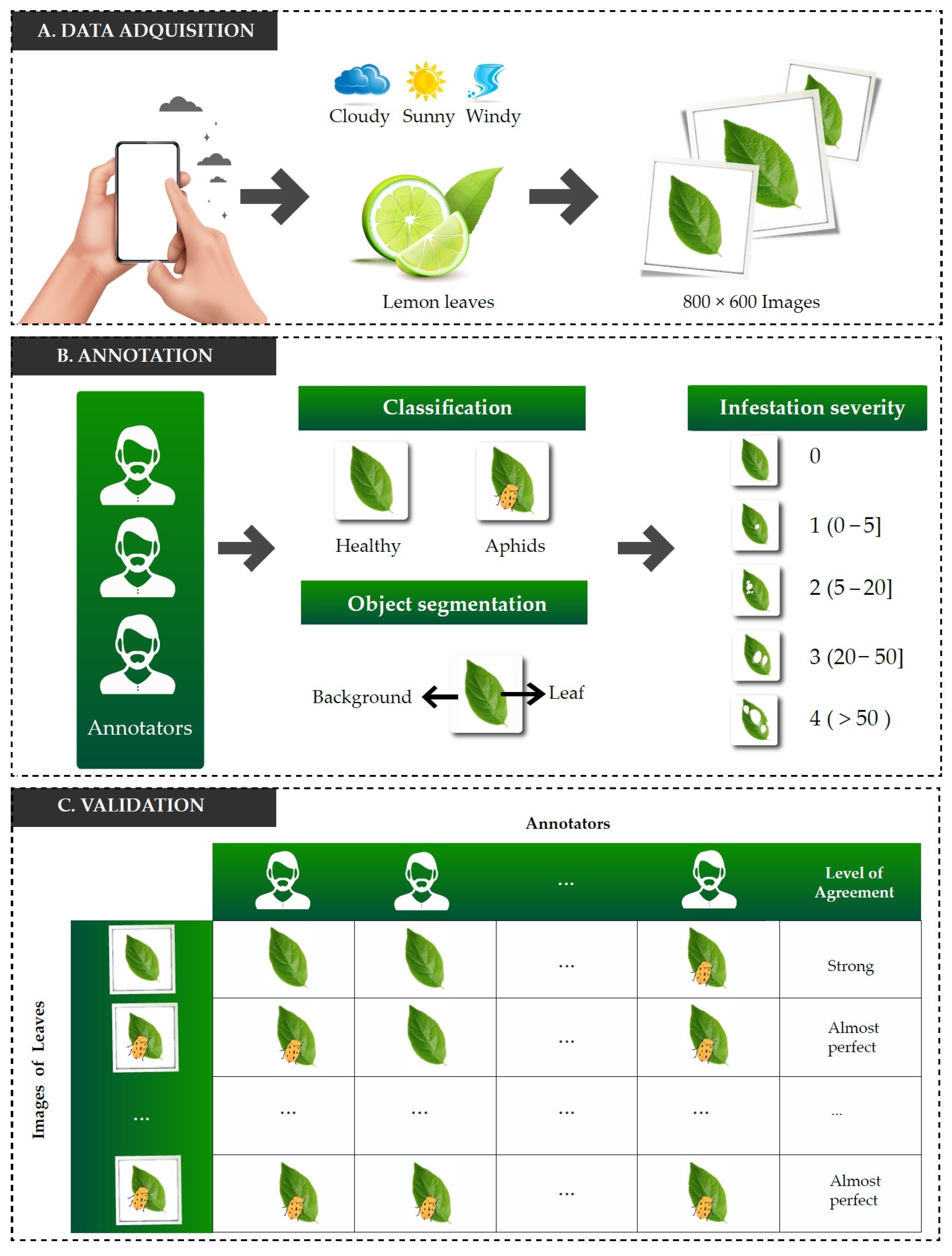LeLePhid: An Image Dataset for Aphid Detection and Infestation Severity on Lemon Leaves
Abstract
:1. Summary
2. Data Description
3. Methods
3.1. Data Acquisition
3.2. Annotations
3.3. Validation
4. User Notes
- The data can be used to train, test, and validate computational models related to image classification on plant disease studies. In this sense, we already have evidence from a previous work [6], where convolutional neural networks (CNNs) were used to board a binary classification problem related to lemon leaves with aphid presence. The quality of LeLePhid was evidenced by allowing the model to achieve average rates between 81% and 97% of correct aphid classification.
- The data can be helpful to researchers and professionals working on computer vision-based models for image segmentation and object detection using images of healthy leaves and leaves with aphid presence. Cases such as those discussed in [3,7] are examples of the potential that our dataset can offer from the point of view of continuous improvement of machine learning algorithms to address segmentation and identification problems related to plant diseases.
- The data can serve as a motivation to encourage further research into the agriculture sector and computer vision methods for citrus pest identification. Image annotation is the data labeling technique used to make the varied objects recognizable for computers. Our dataset includes image annotations of leaves and aphid-infected areas to make them recognizable or even understandable for computers. These annotations can be used to help the large-scale monitoring of the health of crops through, for instance, devices such as UAVs (unmanned aerial vehicles) or drones, where works in [8,9,10,11] have already demonstrated the benefits that can be obtained in the agricultural sector when devices such as drones are used in conjunction with computer vision.
Author Contributions
Funding
Data Availability Statement
Conflicts of Interest
References
- Chen, T.; Zeng, R.; Guo, W.; Hou, X.; Lan, Y.; Zhang, L. Detection of Stress in Cotton (Gossypium hirsutum L.) Caused by Aphids Using Leaf Level Hyperspectral Measurements. Sensors 2018, 18, 2798. [Google Scholar] [CrossRef] [PubMed] [Green Version]
- Virginio-Filho, E.; Astorga, C. Prevención y Control de la Roya del Café. Manual de Buenas Prácticas para Técnicos y Facilitadores; Centro Agronómico Tropical de Investigación y Enseñanza (CATIE): Turrialba, Costa Rica, 2015. [Google Scholar]
- Suo, X.; Liu, Z.; Sun, L.; Wang, J.; Zhao, Y. Aphid Identification and Counting Based on Smartphone and Machine Vision. J. Sens. 2017, 2017, 3964376:1–3964376:7. [Google Scholar]
- Parraga-Alava, J.; Cusme, K.; Loor, A.; Santander, E. RoCoLe: A robusta coffee leaf images dataset for evaluation of machine learning based methods in plant diseases recognition. Data Brief 2019, 25, 104414. [Google Scholar] [CrossRef] [PubMed]
- McHugh, M.L. Interrater reliability: The kappa statistic. Biochem. Medica 2012, 22, 276–282. [Google Scholar] [CrossRef]
- Parraga-Alava, J.; Alcivar-Cevallos, R.; Riascos, J.A.; Becerra, M.A. Aphids Detection on Lemons Leaf Image Using Convolutional Neural Networks. In Systems and Information Sciences; Botto-Tobar, M., Zamora, W., Larrea Plúa, J., Bazurto Roldan, J., Santamaría Philco, A., Eds.; Springer International Publishing: Cham, Switzerland, 2021; pp. 16–27. [Google Scholar]
- Chen, J.; Fan, Y.; Wang, T.; Zhang, C.; Qiu, Z.; He, Y. Automatic Segmentation and Counting of Aphid Nymphs on Leaves Using Convolutional Neural Networks. Agronomy 2018, 8, 129. [Google Scholar] [CrossRef] [Green Version]
- Bah, M.D.; Hafiane, A.; Canals, R. Deep Learning with Unsupervised Data Labeling for Weed Detection in Line Crops in UAV Images. Remote Sens. 2018, 10, 1690. [Google Scholar] [CrossRef] [Green Version]
- Cãlina, J.; Cãlina, A.; Miluț, M.; Croitoru, A.; Stan, I.; Buzatu, C. Use of drones in cadastral works and precision works in silviculture and agriculture. Rom. Agric. Res. 2020, 37, 273–284. [Google Scholar]
- Kitano, B.T.; Mendes, C.C.T.; Geus, A.R.; Oliveira, H.C.; Souza, J.R. Corn Plant Counting Using Deep Learning and UAV Images. IEEE Geosci. Remote Sens. Lett. 2019, 1–5. [Google Scholar] [CrossRef]
- Gomez Selvaraj, M.; Vergara, A.; Montenegro, F.; Alonso Ruiz, H.; Safari, N.; Raymaekers, D.; Ocimati, W.; Ntamwira, J.; Tits, L.; Omondi, A.B.; et al. Detection of banana plants and their major diseases through aerial images and machine learning methods: A case study in DR Congo and Republic of Benin. ISPRS J. Photogramm. Remote. Sens. 2020, 169, 110–124. [Google Scholar] [CrossRef]
| 1. | Aphids are tiny insects that feed by sucking sap from plants, and they can cause diseases. |
| 2. | An adhesive board is placed on the plants, and researchers count the aphids on it. |




| Level | % Affected Area | Symptom |
|---|---|---|
| 0 | 0 | Healthy plant with no aphid presence. |
| 1 | [0–5) | Few aphids. Foliage with no yellowing symptoms. |
| 2 | [5–20) | Crinkling and curling of few leaves of the plant. |
| 3 | [20–50) | Crinkling and curling of leaves almost all over the plant. |
| 4 | >50 | Extreme curling, crinkling, and drying all over the plant. |
| Kappa | Level of Agreement | % of Data Reliability |
|---|---|---|
| 0–0.20 | None | 0–4% |
| 0.21–0.39 | Minimal | 4–15% |
| 0.40–0.59 | Weak | 15–35% |
| 0.60–0.79 | Moderate | 35–63% |
| 0.80–0.90 | Strong | 64–81% |
| Above 0.90 | Almost Perfect | 82–100% |
Publisher’s Note: MDPI stays neutral with regard to jurisdictional claims in published maps and institutional affiliations. |
© 2021 by the authors. Licensee MDPI, Basel, Switzerland. This article is an open access article distributed under the terms and conditions of the Creative Commons Attribution (CC BY) license (https://creativecommons.org/licenses/by/4.0/).
Share and Cite
Parraga-Alava, J.; Alcivar-Cevallos, R.; Morales Carrillo, J.; Castro, M.; Avellán, S.; Loor, A.; Mendoza, F. LeLePhid: An Image Dataset for Aphid Detection and Infestation Severity on Lemon Leaves. Data 2021, 6, 51. https://0-doi-org.brum.beds.ac.uk/10.3390/data6050051
Parraga-Alava J, Alcivar-Cevallos R, Morales Carrillo J, Castro M, Avellán S, Loor A, Mendoza F. LeLePhid: An Image Dataset for Aphid Detection and Infestation Severity on Lemon Leaves. Data. 2021; 6(5):51. https://0-doi-org.brum.beds.ac.uk/10.3390/data6050051
Chicago/Turabian StyleParraga-Alava, Jorge, Roberth Alcivar-Cevallos, Jéssica Morales Carrillo, Magdalena Castro, Shabely Avellán, Aaron Loor, and Fernando Mendoza. 2021. "LeLePhid: An Image Dataset for Aphid Detection and Infestation Severity on Lemon Leaves" Data 6, no. 5: 51. https://0-doi-org.brum.beds.ac.uk/10.3390/data6050051






